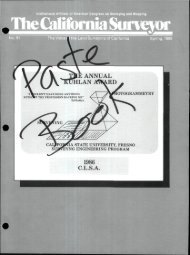The California Surveyor - CLSA
The California Surveyor - CLSA
The California Surveyor - CLSA
Create successful ePaper yourself
Turn your PDF publications into a flip-book with our unique Google optimized e-Paper software.
A Role for the<br />
Land <strong>Surveyor</strong><br />
Introduction<br />
Over the last several years we have<br />
seen the role of the land surveyor<br />
being expanded, and diminished, in<br />
its many components. Technologies<br />
such as Geographic Information<br />
System (GIS) and Global Positioning<br />
System (GPS) were originally<br />
thought to be avenues to more involvement<br />
and more business. <strong>The</strong>y<br />
have, in many instances, resulted in<br />
less work for the surveyor. As these<br />
systems have developed and matured,<br />
their use has been incorporated<br />
by other disciplines. Often lay<br />
people, who don't understand the<br />
basic principles of mapping or measurement,<br />
etc. are used for the<br />
actual work.<br />
Is there a role for the surveyor in<br />
the future of GIS other than providing<br />
ground control for aerial mapping<br />
or adjustment networks or as<br />
a consultant to a GIS vendor? In the<br />
following we will examine one<br />
possibility.<br />
Background<br />
GIS is not new. <strong>The</strong> technology has<br />
been available for many years. Over<br />
that time there has been a large<br />
amount of interest generated in GIS<br />
by the academic community and<br />
public entities. As a result there have<br />
been significant advances in the capabilities<br />
of these systems as well as<br />
a resulting emphasis on goals that<br />
cover a wide spectrum. Without<br />
computers GIS, a complex application,<br />
would not be practical. Without<br />
the dramatic increases in the<br />
power of computers and the dra<br />
in GIS?<br />
By George N. Dumas, PLS<br />
matic reduction of hardware costs,<br />
GIS would not be available to most<br />
entities.<br />
Because of the high cost of computer<br />
hardware in the early days,<br />
the systems were also very expensive.<br />
<strong>The</strong>re were many cities, counties<br />
and some special districts that<br />
were able to budget for, and spend,<br />
the necessary money to buy the<br />
hardware and software. Unfortunately,<br />
in many, if not most cases<br />
there wasn't adequate budget, resources,<br />
or the understanding of the<br />
need for high quality data entry for<br />
the base map information. Because<br />
of this, often corners were cut by<br />
digitizing or scanning this information<br />
and then rubber-sheeting to<br />
force objects to fit together. This<br />
resulted in inaccurate base maps that<br />
became difficult to maintain and<br />
update. Base maps are defined as<br />
the property lines, street and road<br />
center and right of way lines as well<br />
as attribute information describing<br />
them. While accurate base maps<br />
were understood to be a requirement<br />
for a Land Information System (LIS),<br />
most GIS designers didn't see the<br />
need for them. Now, after the above<br />
problems have been surfacing, the<br />
thinking is changing, and more entities<br />
are requiring better base maps.<br />
In other areas GIS were not completed<br />
because they were trying to<br />
input this data by more traditional<br />
but time consuming methods such<br />
as coordinate geometry. <strong>The</strong>y didn't<br />
employ good methods to insure<br />
rapid input and accurate results.<br />
Many of these systems have become<br />
"white elephants." <strong>The</strong>y continue to<br />
cost the governing body a lot<br />
of money and have little or no<br />
productive use. <strong>The</strong>re are some<br />
procedures and systems being<br />
developed to meet these challenges.<br />
<strong>The</strong> following describes one. Land<br />
Records Method DMC.<br />
Overview<br />
<strong>The</strong> past two years has seen an<br />
emergence of a system being built<br />
by a small software company in<br />
Southern <strong>California</strong>. This system<br />
provides for the collection and input<br />
of data into a GIS. It answers some<br />
main problems of the past. It includes<br />
two main parts, the first of<br />
which is the software. Second, even<br />
more important, are procedures for<br />
the research and correlation of record<br />
data before its conversion to electronic<br />
form. This system has resulted<br />
in the ability to create highly accurate<br />
maps. This is done in the same<br />
amount of time that it takes to create<br />
less accurate digitized or scanned<br />
maps.<br />
<strong>The</strong> system, known as Land<br />
Records Method DMC, was developed<br />
by Czerwonka Software. It is<br />
being used by two companies (Earth<br />
Industries of Ridgecrest, CA and<br />
Vectuscan of Santa Paula, CA) to<br />
produce accurate base and facility<br />
maps for cities and utility companies.<br />
<strong>The</strong> map data entry function of<br />
the system uses efficient coordinate<br />
geometry routines that are designed<br />
specifically for this use. <strong>The</strong>se routines,<br />
which run on an IBM-PC or<br />
compatible, use AutoCAD for the<br />
graphics display and Paradox as the<br />
data base. Once the base maps are<br />
built, the remaining map and attribute<br />
information for the facilities<br />
is added with strong reliability.<br />
<strong>The</strong> system has been created to<br />
produce maps that not only can be<br />
used in a GIS but maps that can be<br />
used to do design work as well. "We<br />
built the system," says Larry<br />
Czerwonka, designer of the system,<br />
"to provide surveyors and engineers<br />
with something more than pretty<br />
pictures. It has been my experience<br />
that most GIS applications don't<br />
work well with lots that overlap or<br />
parcels that don't close. But that's<br />
14 <strong>The</strong> <strong>California</strong> <strong>Surveyor</strong> Fall 1992

















